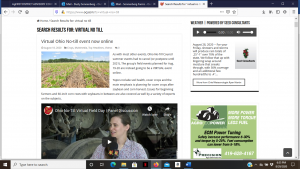Virtual Ohio No-Till Field Day Panel Discussion (Part 1 of 3)
By Dusty Sonnenberg, CCA, Ohio Field Leader: a project of the Ohio Soybean Council and soybean checkoff.
With the restrictions from COVID-19, the Ohio No-till Council made the decision to change their traditional summer field days to a virtual format. Bart Johnson of Ohio’s Country Journal and the Ohio Ag Net moderated a panel discussion focused no-till and cover crops, and highlighting the steps to effectively incorporate cover crops into a multi-crop rotation.
Video’s of the event can be viewed at: https://www.ocj.com/2020/08/virtual-ohio-no-till-event-now-online/ Topics include soil health, cover crops and the main emphasis is planning for cover crops after soybean and corn harvest.  Issues for beginning farmers and 60-inch corn rows with soybeans in between are also covered as well by a variety of experts on the subjects.
Issues for beginning farmers and 60-inch corn rows with soybeans in between are also covered as well by a variety of experts on the subjects.
The opening panel discussion consisted of no-till farmers and cover crop seed dealers. Panelist included: first generation Highland County Farmer Nathan Brown, Plain City Ohio Farmer and long-term no-tiller and seed dealer Fred Yoder, Sandusky County Farmer Martha Winters, and Cody Beacom of Bird Seeds with locations in Mount Vernon and Bowling Green, Ohio.
No-till farming has several positive aspects, but it is not used on every farming operation. Some farmers have elected not to no-till for various reasons. “Incorporating livestock manure was a practice the landlords used on one of the first farms I rented,” said Nathan Brown. “That did not work well with trying to no-till, and it took time to work together with them to find a way they could still apply the manure and not tear up the ground so I could successfully no-till into it.”
Sometimes the reasons farmers do not no-till is economic, other times it is because of tradition and how things have always been done. “One reason no-till is not utilized on more operations is because tillage is fun,” said Fred Yoder. “Tillage is something most farmers are used to doing, because they always have. Tillage can be used either in wetter conditions or dryer conditions, and it is forgiving. No-till is a management tool. No-till takes patience, management and perseverance. If you are not patient and get in the field before it is ready, when it is too wet, there will be negative unintended consequences. You have to be dedicated to doing the right thing.”
There are a number of reasons farmers do choose to change to no-till. “I use no-till for economic reasons,” said Yoder. “After 4-5 years and you see the change in your ground conditions, once that happens, a farmer will probably stay with no-till forever. The ground has to go through a transition. The downside is that there is a 4-5-year transition period that a farmer needs to work through to be successful with no-till. A farmer needs to look at the whole economic picture, and realize that money is saved by having fewer passes for tillage to offset some of the short-term yield reductions they might have.”
Social media and peer pressure can be another factor in farmers not using no-till. “I live in an area and have soils very conducive to no-till, but that doesn’t always make it easy,” said Brown. “It can be a little challenging to stay the course and wait another day for the soil to be fit to plant, when you are driving around, or see on social media, that everyone is out tearing up the soil, and working ground, and you know there is a chance of rain in the forecast. It takes patience, and you need to know what your soil’s limits are.”
No-till farming in an investment. Most think of the investments in terms of land, buildings, and equipment, but having good soil quality is also an investment. “No-till is an investment in your soil profile and quality, kind of like a 401K,” said Yoder. “A farmer needs to keep enhancing their soil profile with investments, just like someone would invest in their retirement. Getting and maintaining soil quality takes long term investments so it can continue to provide a consistent return in future years. If you look for a quick ROI, it is probably not there, but if you give it a couple of years, in the long term it will consistently be there.”